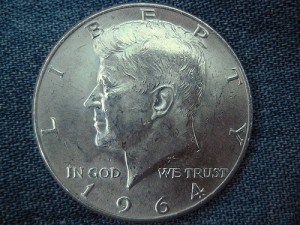
While younger coin collectors look back at the year only in history books, older numismatists remember 1965 very well.
The nation was going through a period of social unrest and lasting changes in popular culture.
Collectors of U.S. coins were having to face their own set of changes that would, in many respects, endure to this very day.
Find out what made 1965 such an interesting year for coin collecters…
1965 Coin Shortage
The United States was facing a coin-shortage crisis in the early- to mid-1960s.
Silver prices had risen significantly above the $1-per-ounce mark.
The U.S. government had to take action against the fact that the silver in its coins was becoming worth more than the denomination stamped on the coins.
In 1965, the U.S. began striking copper-nickel clad dimes and nickels and reduced the amount of silver in half dollars from 90% to 40%.
No Mintmarks On Coins From 1965-1968
But that was not the only move that changed the face of U.S. coins. To discourage the hoarding and collecting of U.S. coins based on mint marks, the Coinage Act of 1965 banned the use of mint marks on coins.
Though the Act required the absence of mint marks for 5 years, in 1968 Congress approved the return of mint marks.
Since 1968, all mint marks have been located on the obverse (front) of coins, instead of the reverse (back), as was the general case until 1965.
Special Mint Sets From 1965-1967
The changes of 1965 did not stop there.
Proof sets and mint sets (sets of coins packaged for collectors containing uncirculated and pristine examples of each year’s coinage) were also halted for 3 years.
In their place came the special mint set — which contains uncirculated examples of coins. Many of these special mint sets contain coins with “proof-like” finishes.
These represent a better-quality, more reflective surface than the coins typically housed in mint sets.
The special mint set was produced from 1965 through 1967, until production of regular mint sets and proof sets resumed in 1968.
Some 1965 And 1966 Coins Actually Dated 1964

Would you believe, that in the name of reducing collecting and hoarding activity, the U.S. government struck coins in 1965 and 1966 that were actually dated “1964”? It’s true!
While the last regularly circulating 90% silver coins were dated 1964, some of these “1964” coins actually did not roll out of the U.S. Mint until 1966.
Copper-nickel clad coinage and 40% silver half dollars were struck bearing the 1965 date. As the United States Department of Treasury website states, “clad coins were not as likely to spark speculation.”
Lincoln cents and Jefferson nickels bearing the 1964 date were also struck throughout much of 1965, and 1965-dated cents and nickels were produced from December 1965 through July 1966.
Values Of 1965 Coins
1965 was a big year for U.S. coins. But for all the changes to the nation’s coins that year, there really is very little monetary value in 1965 coins.
All are highly common. Most of 1965 coins are still found in circulation (except for the 40% silver half dollar). All of these coins are worth nominal prices over face value, even in uncirculated grades.
Speaking of the value of 1965 coins, the 1965 special mint set is worth around $5-$7.




